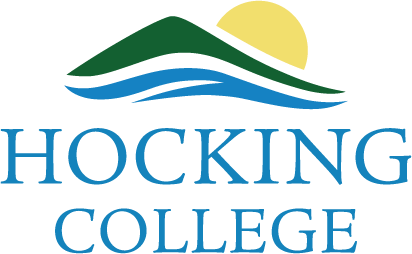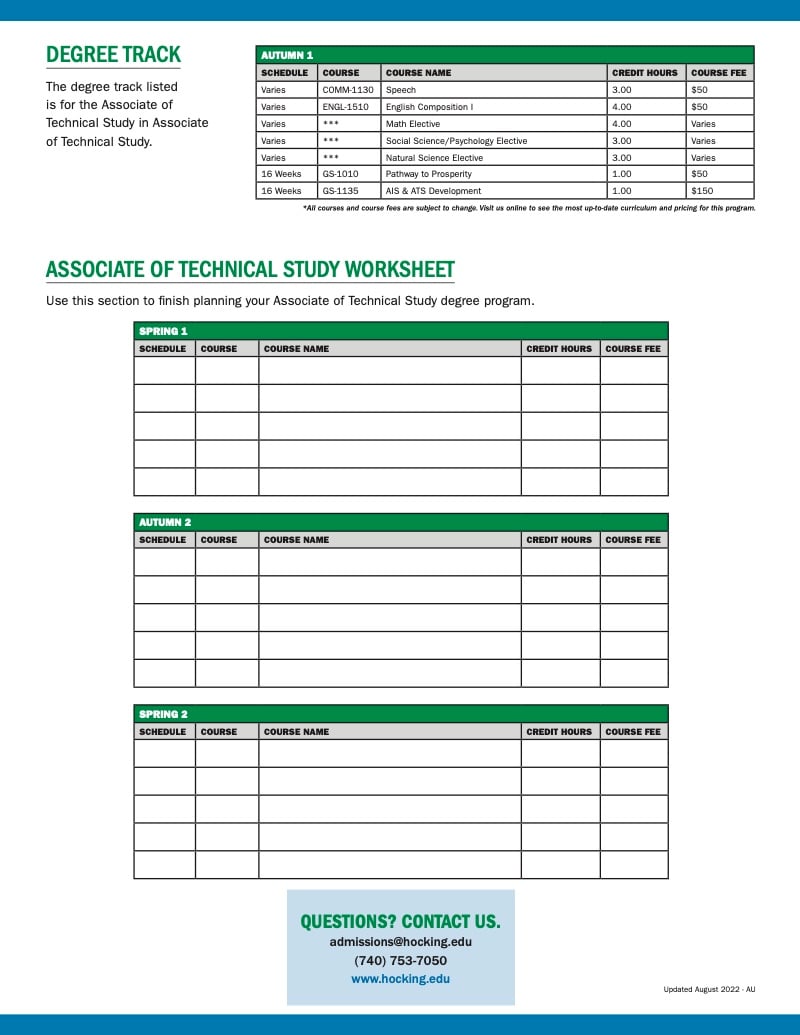Associate of Technical Studies Program Description
The Associate of Technical Study (ATS) is awarded for successful completion of a minimum of 60 credit hours of an individually planned technical education program designed to respond to a student’s need for specialized technical education not currently available in the formal degree programs available at Hocking College, an Ohio technical college.
The typical technical student is seeking a unique, flexible degree that combines two or more technical degree programs from Hocking College, needs a degree as soon as possible for their current job, or has already completed many technical credits but lacks focus in one specific technology.
All-inclusive pricing includes course fees, in addition to the following:
PER SEMESTER
$300......Learning Fee
$20........Health Center Services
$75........Career Center Services
OPTIONAL FEES
$53......Parking
$275....Smart Start*
*Recommended for all first-year college students
Pricing for housing and meal plans can be found online here.
Most students who go on to complete their Associate of Arts degree end up transferring to a 4-year college or university.
Student Learning Outcomes (SLOs) are statements of what a student will be able to do when they have completed a program. They represent the knowledge and skills a program has determined are most important for students to gain from that program and include both the Success Skills (institutional outcomes) and Program Outcomes. SLOs are specific and measurable so the program can accurately assess the degree to which students have achieved each outcome, and they align with college and institution mission and values. Data on the achievement of SLOs is used to make improvements in the program and increase student success.
Hocking College Institutional Learning Outcomes
1) Demonstrate sound critical thinking, information literacy and technological competency in the production of academic writing and presentations
2) Apply the methods of mathematical, statistical or analytical reasoning to critically evaluate data, solve problems and effectively communicate findings.
3) Demonstrate an awareness of the social, political and economic forces which shape individuals, institutions and communities in the modern world.
4)Understand social justice and the diversities and complexities of the cultural and social world past and present and come to an informed sense of self and others.
5)Demonstrate a foundation of knowledge in the natural sciences based on theory and laboratory skills.
6) Cultivate ethical values, personal wellness and personal learning strategies in the development of the whole person, mind, body and spirit.
7) Integrate content material to application in the workforce and apply discipline specific knowledge and skills to successfully transfer or effectively meet the expectations of internships, workplace, volunteerism and/or entrepreneurship endeavors.
8) Utilize the ethical and professional application of current information technology and tools effectively.
Program Outcomes
The following outcomes are skills, behaviors, and attitudes cultivated in students seeking an Associate of Technical Study Major.
- The Associate of Technical Study Major is a customized program designed to meet the career goals of the individual student.
Retention Rates
- All registered fall/autumn students with registration status for the following fall/autumn.
- Excludes special populations - College Credit Plus, Non Degree, Online Military and University Center.
Potential for upcoming fall/autumn excludes graduates from that fall/autumn, spring and summer terms.
| Academic Year | Retention Rate |
| 2016 - 2017 | 45% |
| 2015 - 2016 | 50% |
| 2014 - 2015 | 29% |
Graduation Rates
Graduation rates are determined by the office of Institutional Research. To ensure appropriate time for data collection, this report will be run and posted annually in the last week of September for the previous academic year. It should be noted that annual graduation rates may change as students continue to graduate. The following criteria will be utilized for the calculation of graduation rates:
- Overall Program Completion Rate is defined as a percentage of the ratio:
All graduates of the program
_________________________________________________________________
All students with the program in their history of programs of study - For the purposes of reporting, the program completion rates are aggregated by academic year of entry.
- A student is considered to have completed or graduated from a program or certificate by virtue of having been awarded the degree or certificate.
- A student is considered to be undertaking activity in a program of study for the duration of time that they are in an active status in a program or certificate. This is defined by having a Program of Study with a status of ‘A’ during the duration of time they are taking coursework. Should a student move in and out of active status in a program of study while continuing to take coursework, we only take into account the student’s activity while the program has an active status for that particular program of study.
| Academic Year | Graduation Rate |
| 2016 - 2017 | 6.11% |
| 2015 - 2016 | 41.94% |
| 2014 - 2015 | 34.29% |
What is the difference between the Associate of Arts and the Associate of Science?
All classes in both curriculums are transferable, but there is a slight difference in the curriculum. Associate of Arts students
What is an Associate of Technical Studies (ATS) and what are the requirements?
Some AA and AS students want more curriculum flexibility and can design their own curriculum by splitting required technical credits between two different fields of study.
For example, a student might want to take 15 credits from the Business curriculum and 15 credits from the Accounting curriculum along with the 30+ required general credits to create an Associate of Technical Studies. Business and Music Management is another example of an ATS degree that combines the curriculum of two majors to create a degree unique to student needs.
Can AA/AS advisors help students figure out how to begin the process of transferring to another institution?
Yes, academic advisors can help students figure out how to access information about transferring to other colleges in





